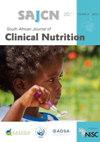食品和营养标签作为营养教育工具:南非营养师的理解、观点和实践。
IF 0.6
Q4 NUTRITION & DIETETICS
引用次数: 1
摘要
导言:食品和营养标签是解决与饮食有关的非传染性疾病的有效工具,营养教育在其中发挥着不可或缺的作用。目的:调查南非营养师对食品和营养标签作为营养教育工具的理解、观点和做法。设计:进行定量描述性横断面研究。背景:在全国范围内对所有执业部门的营养师进行了调查。研究对象:在南非卫生专业委员会(HPCSA)注册的营养师(n = 137)。结果测量:数据收集采用自我管理的电子调查。结果:标签法规知晓率高(86.9%);然而,缺乏对法规知识的信心(53.3%),以及对食品标签法规(R146)的知识(52.6%)。超过一半(57.7%)的受访者认为标签与他们的日常工作有关,51.8%的受访者经常使用标签,并根据客户的需要使用不同的标签。在教育方面,最常使用的是营养信息表(75.2%)、客户特定营养素(70.0%)和健康背书标识(HELs)(59.2%)。评价产品健康程度的主要指标为烹饪方法(86.1%)、加工水平(67.9%)和产品类别(63.5%)。使用最少的方面是原产地/认证声明(39.4%)和畜牧业(34.3%)。评价较高的方面包括对标签有效性的信念(88.3%)、准确性(81.8%)、积极态度(87.6%)和相关性(80.2%)。结论:为了促进标签作为营养教育工具的最佳使用,必须解决标准化、可信度和继续教育问题。此外,食品标签法规草案的紧急颁布将解决标签使用的现有障碍。本文章由计算机程序翻译,如有差异,请以英文原文为准。
Food and nutrition labelling as a nutrition education tool: understanding, perspectives and practices of South African dietitians.
Introduction: Food and nutrition labelling is an effective tool to address diet-related non-communicable diseases (NCDs), in which nutrition education plays an integral role. Objectives: To investigate South African dietitians’ understanding, perspectives and practices of food and nutrition labelling as a nutrition education tool. Design: A quantitative descriptive cross-sectional study was conducted. Setting: A nationwide survey was undertaken of dietitians from all sectors of practice. Subjects: Dietitians registered with the Health Professions Council of South Africa (HPCSA) (n = 137). Outcome measures: A self-administered electronic survey was used for data collection. Results: Awareness of labelling regulations was high (86.9%); however, confidence in knowledge of regulations was lacking (53.3%), as well as knowledge regarding food-labelling regulations (R146) (52.6%). More than half (57.7%) regarded labels as relevant to their daily work and 51.8% used labels frequently, varying use depending on client needs. For education purposes, the nutrition information table (75.2%), client-specific nutrients (70.0%) and health endorsement logos (HELs) (59.2%) were most frequently used. Product healthiness was mainly evaluated using the cooking method (86.1%), level of processing (67.9%) and product category (63.5%). Least used aspects were origin/certification claims (39.4%) and animal husbandry (34.3%). Highly rated aspects included belief in label efficacy (88.3%), accuracy (81.8%), a positive attitude (87.6%) and relevance (80.2%). Conclusion: To promote optimal use of labelling as a nutrition education tool, standardisation, trustworthiness and continuing education should be addressed. Furthermore, the urgent promulgation of the draft food labelling regulations will address existing barriers to label use.
求助全文
通过发布文献求助,成功后即可免费获取论文全文。
去求助
来源期刊

South African Journal of Clinical Nutrition
NUTRITION & DIETETICS-
CiteScore
2.50
自引率
9.10%
发文量
21
期刊介绍:
1.The Journal accepts articles from all basic and applied areas of dietetics and human nutrition, including clinical nutrition, community nutrition, food science, food policy, food service management, nutrition policy and public health nutrition. 2.The Journal has a broad interpretation of the field of nutrition and recognizes that there are many factors that determine nutritional status and that need to be the subject of scientific investigation and reported in the Journal. 3.The Journal seeks to serve a broad readership and to provide information that will be useful to the scientific community, the academic community, government and non-government stakeholders in the nutrition field, policy makers and industry.
 求助内容:
求助内容: 应助结果提醒方式:
应助结果提醒方式:


